Book

Electric Motors for Hybrid and Pure Electric Vehicles 2015-2025: Land, Water, Air
2014-11-01
The electric vehicle business will approach a massive $500 billion in 2025 with the traction motors segment capturing over $25 billion. Traction motors propelling land, water and air vehicles along can consist of one inboard motor or - an increasing trend - more than one near the wheels, in the wheels, in the transmission or ganged to get extra power. Complex trends in this industry are explained with this updated report, and future winning suppliers are identified alongside market forecasts. The information is especially important as hybrid vehicles may have the electric motor near the conventional engine or its exhaust, and this may mean they need to tolerate temperatures never before encountered in pure electric vehicles. Motors for highly price-sensitive markets such as electric bikes, scooters, e-rickshaws and micro EVs avoid the price hikes of neodymium and other rare earths in the magnets.


